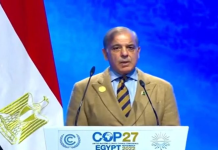ISLAMABAD, Dec 04 (APP): The Climate Hub Forum (CHF) and the Forest, Wildlife and Environment Department of Gilgit Baltistan (GB) in a high-level session during COP29 convened leaders, experts and activists to explore how sustainable tourism can coexist with conservation efforts in the breathtaking region of GB.
The event, “Uniting Conservation, Community and Tourism for the Future of Gilgit-Baltistan’s National Parks,” emphasized the urgent need to protect one of the world’s most ecologically significant landscapes while offering pathways for sustainable development.
Organized by the Forest, Wildlife and Environment Department of the Government of Gilgit-Baltistan in partnership with the Climate Hub Forum, the session brought together voices from across the globe, each advocating for a unified approach to environmental stewardship.
From the towering peaks of the Himalayas to the dense, pristine forests, GB’s unparalleled biodiversity was presented as both a treasure and a challenge. It is home to some of the world’s highest mountains, glaciers, and unique wildlife like the snow leopard and Himalayan brown bear. But as the session made clear, the region faces an existential threat from climate change, unsustainable tourism, and habitat loss.
The gathering highlighted how crucial it is to balance the growth of tourism—now a major economic driver in the region—with the need for effective conservation. In 2022, GB saw 2 million visitors, a staggering 30 percent increase from the previous year. Yet this surge in tourism has come with its own set of problems: overflowing waste, threats to fragile glaciers, and a lack of eco-friendly infrastructure.
Project Director of the Forest, Wildlife & Environment Department, Ismael in his opening remarks presented a vivid picture of the environmental challenges facing GB while emphasizing the importance of national parks like Himalaya National Park and Nanga Parbat National Park.
“Together, these parks span over 3,600 square kilometers and are vital to conserving endangered species like the Ladakh urial and snow leopard, whose populations are dwindling due to habitat destruction and climate change. These parks are part of Pakistan’s broader initiative to expand protected areas, with a target of covering 15% of the country’s land. This initiative is not only key to preserving biodiversity but also promises green jobs for local youth, which is a significant step toward economic empowerment,” he said.
Former Secretary of Forest and Wildlife in GB, Shahid Zaman elaborated on the importance of these national parks, calling them “a globally significant nature corridor” that supports a range of endangered species. He stressed the need for consistent support and investment to ensure their long-term sustainability.
Country Representative for IUCN Pakistan, Mahmood Akhtar Cheema added his voice to the call for community-based conservation. He emphasized the importance of empowering local populations to actively engage in protecting their natural resources. In GB, this approach has already proven effective, with many communities involved in reforestation and wildlife protection efforts. Cheema also called for more robust monitoring systems to track the health of endangered species and their habitats, ensuring that conservation strategies are data-driven and adaptable.
One of the session’s most impactful discussions came from Erum Khan, Chairperson of the Climate Hub Forum. As a seasoned advocate for sustainable tourism, Khan highlighted GB’s rapidly growing tourism sector, but warned that the region’s current infrastructure is not equipped to handle such an influx without severe environmental consequences. The region generates a staggering 50 tons of waste annually, and nearly a third of its glaciers are at risk due to warming temperatures.
She also urged for the creation of a Climate Resilience Fund, which would support glacier conservation and the development of climate-resilient infrastructure.
“We need integrated policies and partnerships that align tourism development with conservation goals,” Khan emphasized.
The session concluded with a series of key recommendations, aimed at creating a sustainable future for both the environment and the people of Gilgit-Baltistan including a Sustainable Tourism Framework, empowering local people through Community Engagement and Green Jobs, enhanced Protected Areas Management, and establishment of the Climate Resilience Fund to protect GB’s glaciers and biodiversity, which are crucial to the region’s climate resilience.
The urgency of these initiatives was underscored by the absence of Aamir Sadozai, Co-Founder of the Climate Hub Forum, who, despite being unable to attend, shared a powerful message calling for stronger public-private partnerships and innovative financing mechanisms. He stressed that GB’s environmental and cultural significance makes it imperative to adopt policies that balance tourism with conservation, empowering local communities as the true custodians of their natural resources.
The session at COP 29 proved that Gilgit-Baltistan has the potential to be a global model for harmonizing conservation, community development, and sustainable tourism. As speakers pointed out, the region’s natural beauty and biodiversity are irreplaceable, and it is essential that they be preserved for future generations.
CHF highlights uniting conservation, community amid sustainable tourism in GB at COP29
مضمون کا ماخذ : لوٹیریا کا نتیجہ








.jpg)





